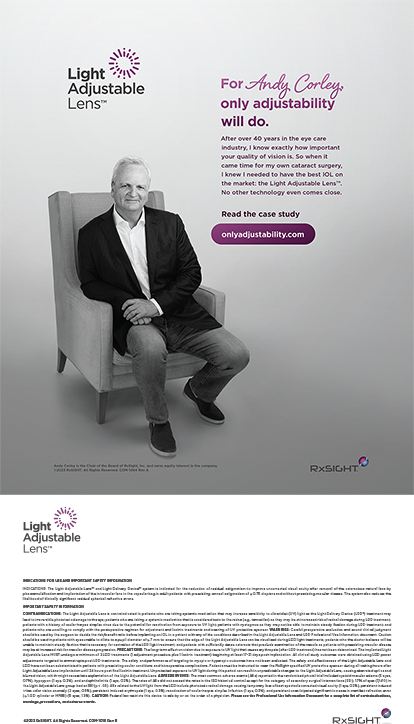
Comparison of Visual Outcomes, Alignment Accuracy, and Surgical Time Between 2 Methods of Corneal Marking for Toric Intraocular Lens Implantation
Mayer WJ, Kreuzer T, Dirisamer M, et al1
Industry support: No
ABSTRACT SUMMARY
This prospective randomized study included 57 eyes of 29 patients who underwent cataract surgery and toric IOL implantation. Toric IOL power calculations were performed with the Z-calc software (Carl Zeiss Meditec) and simulated keratometry. Scheimpflug topography values for the central 4.0 mm were used to determine the corneal astigmatism. All patients received the AT Torbi 709M (Carl Zeiss Meditec, not available in the United States). In group 1, manual marking was performed with a bubble marker instrument (Nuijts-Lane marker, ASICO) while the patient was seated upright. In group 2, digital marking was performed with the Forum Cataract Workplace platform (Carl Zeiss Meditec); a reference image was displayed as an overlay seen through the microscope.
STUDY IN BRIEF
A prospective randomized study compared a digital marking method with a manual bubble method for toric IOL alignment. The digital method achieved better results with regard to deviation from the target induced astigmatism, postoperative IOL misalignment, and surgical time.
WHY IT MATTERS
Although manual marking methods give reliable results, they have some limitations. The digital marking system used in this study significantly reduced intraoperative misalignment of toric IOLs and shortened surgical time.
No significant difference was found between the two groups in terms of preoperative spherical equivalent, cylinder, uncorrected distance visual acuity, or corrected distance visual acuity. Rotational stability was excellent in both groups; mean postoperative IOL misalignment was slight (2.00º ±1.86º and 3.40º ±2.37º in the digital and manual groups, respectively, P = .026). The target induced astigmatism was significantly lower in the digital group than in the manual group (P = .008). The difference in postoperative cylindrical power between the two groups was not statistically significant (P = .063). The time required to perform various steps of the surgery was significantly shorter both intra- and postoperatively in the digital group (P = .001, for each comparison).
DISCUSSION
In current practice, a main goal of the cataract surgeon is to provide spectacle independence to patients after cataract surgery. Toric IOLs can provide greater spectacle independence and lower postoperative residual astigmatism than nontoric IOLs.2 For the best results, the axis of the toric IOL must be aligned exactly with the axis of corneal cylinder, which requires exact corneal marking. Although the accuracy of manual marking methods is high, computer-guided methods have been developed to overcome the limitations of manual methods.3,4
Mayer et al evaluated the efficacy of a computer-assisted marking system for toric IOLs, the Callisto eye system (Carl Zeiss Meditec), and compared the results with those achieved using a manual marking technique.1 The investigators found better toric IOL alignment and lower deviation from the target induced astigmatism in the digital marking group compared to the manual marking group. They also found the preoperative procedure and toric IOL alignment to be faster in the digital group, translating to shorter overall surgical time.
Comparison of Toric Intraocular Lens Alignment Error With Different Toric Markers
Lipsky L, Barrett G5
Industry support: No
ABSTRACT SUMMARY
For this retrospective cohort study, investigators compared errors in toric IOL alignment using two toric markers. The study included 72 eyes of 56 patients from two centers who underwent surgery by the same ophthalmologist and received a hydrophobic IOL (AcrySof IQ Toric IOL, model SN6AT2, versions T2–T8, Alcon). For all eyes, the reference meridian was determined with a mobile phone app, toriCAM, developed by Graham D. Barrett, MD. The desired implantation meridian was marked with a Barrett Dual Axis Toric Marker (Duckworth & Kent) in group 1 and with a Mendez degree gauge (Bausch + Lomb Storz Ophthalmic Instruments) in group 2.
STUDY IN BRIEF
This retrospective cohort study compared errors in toric IOL alignment using two toric markers and found that mean absolute toric IOL alignment error was significantly lower with one of the instruments, such that a higher percentage of eyes in that group achieved a manifest refraction astigmatism of 0.50 D or less after surgery.
WHY IT MATTERS
Accurately aligning toric IOLs is of the utmost importance to achieve effective astigmatic correction.
The data on degree of preoperative cylinder and type of corneal astigmatism (with- or against-the-rule), axial length, and toric power of the implanted IOL did not differ significantly between groups (P = .75, .505, .88, and .285, respectively). The mean absolute toric IOL alignment error (intended vs actual alignment at 1 month) was statistically significantly lower in group 1 (4º vs 8.4º, P = .0015). Group 1 had better alignment outcomes (ie, degrees within an intended axis) than group 2 (within ±5º, P = .0024; within ±10º, P = .0077). Additionally, a significantly higher percentage of eyes in group 1 achieved a manifest refractive astigmatism of 0.50 D or less after surgery (P = .0445).
DISCUSSION
Misalignment of a toric IOL is defined as the difference between the desired implantation meridian and the final achieved position of the IOL.5 Misalignment may be caused by either intraoperative alignment error or postoperative rotation of the IOL. Inoue et al showed that postoperative rotation of a toric IOL usually occurred within the first hour, and this postoperative rotation was responsible for the majority of errors in toric IOL alignment.6
The three causes of intraoperative misalignment are an error in determining the reference meridian, an error in marking the desired meridian of implantation, and misalignment of the IOL with the target meridian.7 To avoid cyclotorsion, the eye should be marked while the patient is seated upright.
There are several methods of marking the reference and implantation meridians, including freehand, slit-lamp–assisted, gravity-based, an image-guided system, and the toriCAM app. With the toriCAM app, the reference is marked, the meridian is measured, and the implantation meridian is then adjusted accordingly. This method has been shown to reduce the reference marking error to 1.28º (67%).8
1. Mayer WJ, Kreuzer T, Dirisamer M, et al. Comparison of visual outcomes, alignment accuracy, and surgical time between 2 methods of corneal marking for toric intraocular lens implantation. J Cataract Refract Surg. 2017;43(10):1281-1286.
2. Kessel L, Andresen J, Tendal B, Erngaard D, Flesner P, Hjortdal J. Toric intraocular lenses in the correction of astigmatism during cataract surgery: a systematic review and meta-analysis. Ophthalmology. 2016;123(2):275-286.
3. Woo YJ, Lee H, Kim HS, Kim EK, Seo KY, Kim TI. Comparison of 3 marking techniques in preoperative assessment of toric intraocular lenses using a wavefront aberrometer. J Cataract Refract Surg. 2015;41(6):1232-1240.
4. Osher RH. Iris fingerprinting: new method for improving accuracy in toric lens orientation. J Cataract Refract Surg. 2010;36(2):351-352.
5. Lipsky L, Barrett G. Comparison of toric intraocular lens alignment error with different toric markers. J Cataract Refract Surg. 2019;45(11):1597-1601.
6. Inoue Y, Takehara H, Oshika T. Axis misalignment of toric intraocular lens: placement error or postoperative rotation. Ophthalmology. 2017;124(9):1424-1425.
7. Visser N, Berendschot TT, Bauer NJ, Jurich J, Kersting O, Nuijts RM. Accuracy of toric intraocular lens implantation in cataract and refractive surgery. J Cataract Refract Surg. 2011;37(8):1394-1402.
8. Pallas A, Yeo TK, Trevenen M, Barrett G. Evaluation of the accuracy of two marking methods and the novel toriCAM application for toric intraocular lens alignment. J Refract Surg. 2018;34(3):150-155.




